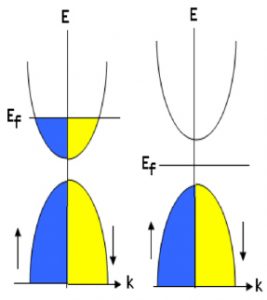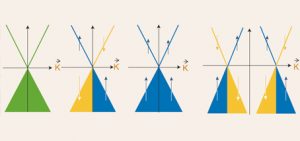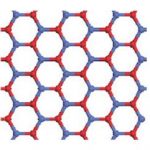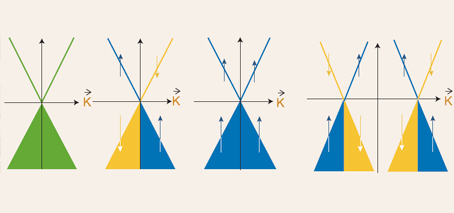A University of Wollongong study has tightened the search for materials that would allow for ultra-fast, ultra-low energy ‘spintronic‘ electronics with no wasted dissipation of energy from electrical conduction.
Spintronics is an emerging field of electronic study in which the ‘spin’ of electrons (their intrinsic angular momentum) is used in addition to their charge.
Conventional electronics and information technology are based on the electron’s charge, while the new science of ‘spintronics’ deals with both the spin and the charge of electrons. With twice as many degrees of freedom to manipulate, spintronic devices have the potential for much more efficient data storage and transfer of information.
The ultimate goal for spintronic devices is ultra-fast and ultra-low-power electronics.
This requires:
- fast, ‘dissipationless’ transport of electrons – ie, they should not dissipate energy as they traverse the material, which is the case in conventional electronics
- manipulation of charge and spin using only small, applied external energy, so that it can be practically controlled
- achievable at room temperature – ie, not be limited to very cold temperatures of several hundred degrees below zero.
To meet these requirements, researchers have sought ways to eliminate the mass of charged particles, and to make those massless charges fully electron spin-polarised –ie, have only one spin orientation.
One of the most promising candidates are materials known as spin-gapless semiconductors, in which charged particles can be fully spin-polarised.
Spin-gapless semiconductors (SGSs) were first proposed by the University of Wollongong’s Xiaolin Wang in 2008, and are regarded as a new class of materials that bridge semiconductors and half-metals. Prof Wang proposed that there are four different types of SGSs for both linear and parabolic energy–momentum dispersion.
In this latest study, Xiaoliang Wang has highlighted the new physics of SGSs with linear dispersion, known as Dirac-type spin-gapless semiconductors. These are ideal platforms for massless and dissipationless spintronics.
But first, to understand what makes a SGS special, you might need to understand a bit of band theory, the solid-state theory that explains conduction in materials.
Band structure

Bandgaps between valence (lower) and conduction (upper) bands in (from left to right) a metal (small gap), and insulator or semiconductor (larger gap)
In solid-state band theory, materials in nature can be classified as metals, insulators or semiconductors based on their electronic band structures.
A valence band contains a material’s highest energy electrons. Just ‘above’ this (ie, more energetic) is the conduction band, which is the lowest band of vacant electronic states.
In a metal, conduction electrons located in the conduction band, so that electrons (ie, an electric current) can flow easily in a metal. In an insulator, the two bands are separated by a large gap so that electrons cannot flow. In semiconductors, such as the silicon that forms the basis of traditional integrated circuits and transistors, the bands are separated by a smaller gap, so that the application of a small threshold energy can boost electrons into the conduction band. This is essentially how silicon transistors ‘switch’.
In a spin-gapless semiconductor (SGS), conduction and valence band edges touch, and no threshold energy is required to move electrons from occupied (valence) states to empty (conduction) states. This gives these materials unique properties: their band structures are extremely sensitive to external influences (eg, pressure or magnetic field). For Dirac type SGS, their electron mobility is two to four orders of magnitude higher than in classical semiconductors
Because very little energy is needed to excite electrons in an SGS, charge concentrations are very easily ‘tuneable’. For example, this can be done by introducing a new element (doping) or by application of a magnetic or electric field (gating).
Spin gapless semiconductors (SGSs)
The concept of spin gapless semiconductors (SGSs) were first proposed by Xiaolin Wang in 2008 in a paper published in Physical Review Letters.
Their properties are extremely sensitive to external stimuli – for example, their properties can be easily changed by a small, applied magnetic or electric field, or by a mechanical strain applied to the material.
This property makes SGSs an exciting material with great potential for improved spintronics, as well as magnetic, optical, mechanical and chemical sensors.

Band structures of Dirac-like systems: spin-degenerate
systems (a), surface or edge states of topological
insulators (b), spin-gapless state of type I (c) and Weyl
semimetals (d).
Wang has proposed new physical properties for the Dirac-type spin gapless semiconductors – that it is suitable for creating massless, dissipationless electronic flow, and potentially could allow for ultra-fast, ultra-low-power spintronic devices.
In a Dirac-type SGSs, when spin-orbital coupling plays a role, a gap will be opened for the spin fully-polarized conduction and valence band. As a result, the interior of the sample becomes an insulator, however, an electrical current can flow without resistance at the sample edge.
This effect is called quantum anomalous effect (QAHE) which has only been realised in magnetically doped topological insulators.
Wang proposes that SGSs and Dirac type SGSs are new, very promising platforms for achieving QAHE besides their fascinating full spin polarizations. Novel spin Hall effects are also proposed.
Avoiding energy dissipation
In silicon-based and other traditional semiconductor circuits, electrons scatter off imperfections and structure to dissipate energy. It is this wasted energy that makes up the bulk of the 5% of global electricity being consumed in information technology (IT) server farms and data centres.
In the new, proposed material, Dirac-typs SGSs, Dirac dispersion allows the electron’s (effective) mass to be eliminated. Dirac-type spin gapless semiconductors can achieve dissipationless charge transport at the sample edge by separating out fully spin-polarised charges using an applied external field or internal magnetisation.
Tightening the search for material candidates

Atomically thin manganese oxide in a honeycomb lattice
A number of potential candidates for Dirac-type SGS have been reviewed in Wang’s latest work. However these materials proposed have to be experimentally fabricated which are challenging as they are atomically thin materials The search for the right Dirac SGSs material is based on atomically thin materials with honeycomb lattices. In the recent paper, Wang verified by DFT calculations that the Dirac SGSs are possible in ferromagnetically ordered simple oxides with either honeycomb or squre lattices, Wang proposed there are two key selection criteria for massless, dissipationless spintronics: namely, they are ferromagnetic, and they have suitable lattices to create the necessary band structure.
Based on these results, it seems that such states probably also exist in a wide range of other transition metals or rare earth oxides in ferromagnetic states.
The search for Dirac SGSs for massless and dissipationless spintronics will certainly stimulate more interest in searching for more material candidates, and it seems very likely that we will see successful, experimental massless and dissipationless spintronics in the near future
Wang’s team is continuing the search for Dirac-type SGSs, with an emphasis on 3D compounds. Meanwhile, his team has been fabricating real samples of SGSs and studying their exotic spin and charge properties with the ultimate goal of achieving dissipationless current flow using the quantum anomalous Hall effect (QAHE).
Funding was received from the Australian Research Council (ARC) through an ARC Discovery Project and an ARC Professorial Future Fellowship project. The work was published in the National Science Review in June 2017.

Xiaolin Wang
Prof Xiaolin Wang leads FLEET’s University of Wollongong node, as well as leading the Enabling Technology team developing the novel and atomically thin materials underpinning FLEET’s search for ultra-low energy electronics, managing synthesis and characterisation of novel 2D materials at the University of Wollongong and Monash University as well as partner organisations (Tsinghua, NUS and ANSTO).
He leads FLEET’s efforts to exploit charge and spin quantum effects in magnetic topological insulators as well as fabricating high-quality samples for joint research with FLEET researchers at Monash, UNSW, ANU and RMIT.
Want to learn more? You can follow FLEET on Twitter, watch a video on future solutions to computation energy use, or subscribe to FLEET news.

